The best workforce management software should streamline the day-to-day management of your employees, simplify shift and schedule planning and managing time off, optimize employee on-the-job productivity, and help control labor costs. In this guide, we evaluated some of the most popular workforce management tools and chose the top five providers:
- Homebase: Best overall
- When I Work: Best for distributed workforces
- Deputy: Best HR platform with workforce management features
- Connecteam: Best for mobile teams
- Zoho People: Best in affordability
Featured Partners: Workforce Management Software
Top Workforce Management Software Compared
All the providers we evaluated have shift swapping, time tracking, leave management, and a mobile app. We also checked if they sync with payroll and POS, geolocation capabilities, and labor planning. The table below gives you an overview of their differences and similarities:
Starts At | Key Features | Star Rating | |
|---|---|---|---|
$24.95/location/month; unlimited users |
| 4.29 / 5 | |
$2.50/user/month |
| 4.15 / 5 | |
$4.50/user/month |
| 4.11 / 5 | |
$35/month for the first 30 users + $0.6/additional user/month |
| 3.97 / 5 | |
$1.50/user/month |
| 3.81 / 5 | |
Homebase: Best Overall

Pros
- Has a free plan
- Automatically applies leave/pay laws to your schedules
- Applicant tracking is a free feature
Cons
- PTO customization only in higher tier
- Free version is limited to 20 employees and one location
- Mobile app is glitchy
Overview
Who should use it:
Homebase’s pricing plan and features are designed for businesses with multiple locations, such as stores, hotels, and restaurants. Instead of a per-user pricing format like the other providers on this list, Homebase charges per location and has a tip manager feature that automatically calculates the tip pools and includes it in your timesheets. These features have also placed Homebase at the top of our best retail employee scheduling software.
While its free version is limited to 20 employees, its paid plans allow unlimited employees for each location, which also makes it perfect for businesses that are scaling fast. Additionally, it has HR features, such as employee engagement, task management, and employee training as well as compliance tools that help businesses operate within the law.
Why I like it:
One of the primary reasons why I like Homebase (and why it got our top spot) is its ease of use, from setup to implementation. Its setup process involves an easy-to-follow step-by-step guide in the form of prompts. It also has a checklist to give you an overview of what you’ve finished and what you still need to do. While other providers on this list have a straightforward setup process, only Homebase automatically applies any pay/leave laws of your state to your schedules. All you need is to enter your zip code. This ensures you stay compliant when you create schedules and assign tasks.
Homebase got a perfect score for its pricing and a high score for its scheduling features. However, it scored low on its support and communication/collaboration criteria because it lacks 24/7 support and most of its collaboration and communication features are in the higher tier plans.
Pricing
- Basic (Free, 1 location/20 employees): Basic scheduling and time tracking, applicant tracking system, job posting, POS integrations, employee mobile app
- Essentials ($24.95/location/month/unlimited employees): Everything in Basic + team communication, shift swapping, flexible pay benefits, availability and time off request management
- Plus ($59.95/location/month/unlimited employees): Everything in Essentials + hiring, PTO & time-off controls, role-based permissions, retention & performance
- All-in-one ($99.95/location/month/unlimited employees): Everything in Plus + HR compliance and labor cost management
Add-ons
- Payroll: $39/month base fee + $6/employee/month
- Tip Manager: $25/location/month
- Background Checks: $30 each
- Task Manager: $13/location/month
- Job Post Boosts: $79/post
Key Features
- Attendance Tracking: This feature not only tracks the clock in/clock out of employees but it also snaps photos to confirm who is clocking in/out and has geolocation to show exactly where your employee is. Additionally, Homebase is the only provider on this list that gives a unique PIN code for each employee which they use to clock in/out. With these features in place, you can prevent time theft.
- Hiring and Onboarding: Just like Deputy, Homebase also has job posting templates. However, Homebase has more than 130 job posting templates, giving you more options to personalize your job site. It also allows you to manage walk-ins and referrals with a text-to-apply code.
- Role-based Permission: This feature enhances security, simplifies administration, and improves compliance. While Deputy, Connecteam, and When I Work also have this feature, Homebase allows unlimited users per department. This is ideal for growing businesses or large organizations as it can accommodate more users.
- Automated Tip Manager: Homebase’s unique feature, it automatically calculates tips from your POS and adds them to your timesheets. This saves you time and also from errors compared to manually doing the calculations. It also ensures that you stay in compliance with payroll laws.
- Live Support from HR Advisors: Another unique Homebase feature that the other providers on this list do not have. The feature gives you access to HR experts, allowing you to ask guidance regarding HR policies or other similar questions.
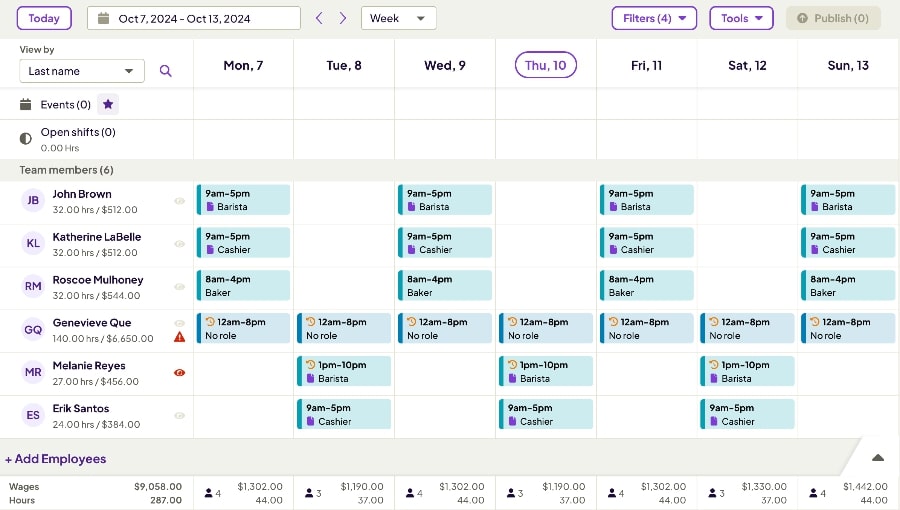
Homebase not only displays your schedules but also the total cost of your employees’ wages for the pay cycle. (Source: Homebase)
When I Work: Best for Distributed Workforce

Pros
- Payroll and POS integration in its basic plan
- Can create custom time-off policies
- Automatically deducts breaks from timesheet
Cons
- Lacks 24/7 support on lower-tier plans
- Limited integrations
Overview
Who should use it:
When I Work is ideal for companies with an international presence or remote teams. It has features like multi-location scheduling, shift tracking, and customizable time and attendance policies, which support such operations. Additionally, its time zone feature allows seamless scheduling and task management across different regions.
Why I like it:
Although When I Work has no free plan, its basic plan is packed with features compared to other providers on this list. It includes features like forecasting, multi-location scheduling, two-factor authentication, and POS and payroll integration in its basic plan, which can only be found in the higher-tier plans of the other providers on this list. This is a steal for businesses (especially those with a smaller team) that need a comprehensive workforce management software without spending much.
It scored higher than Homebase in the time & attendance and communication & collaboration criteria. However, it lacks 24/7 customer support, which may be a consideration for some businesses. And, unlike Homebase, Connecteam, and Zoho People, it does not have a free plan.
Pricing
Without Time and Attendance
- Essential ($2.50/user/month): Shift swapping, multi-location scheduling, forecasting tools, in-app messaging, schedule templates, and live chat
- Pro ($5/user/month): Everything in Essential + toggle between time zones, role permissions, labor sharing, and toggle between time zone
- Premium ($8/user/month): Everything in Pro + API key access and SSO
With Time and Attendance
- Essentials: $4/user/month
- Pro: $7/user/month
- Premium: $10/user/month
Add-ons
- Payroll: $36/month + $6/active user/month
Key Features
- Two-Factor Authentication: While all the other providers have a good level of security, When I Work has taken an extra step by including this feature in its basic plan. Connecteam also has this feature but is included in its highest-tier plan. With this feature, even businesses in the basic plan have an extra layer of time fraud prevention (prevents buddy punching).
- Labor Forecasting: Aside from estimating upcoming workload or customer demand, When I Work’s labor forecasting tool also displays how much it will cost you based on the employee’s wage, including overtime. This removes any surprises on wage costs because everything is laid out already.
While Homebase has the same features, it’s included in its highest tier plan, whereas When I Work has it in its basic plan. Having this feature allows companies to optimize their staffing levels, reduce labor costs, and improve operational efficiency by accurately predicting workforce needs.
- Multi-location Scheduling: This feature enables companies to efficiently manage and coordinate employee schedules across multiple sites, improving resource allocation and operational effectiveness. While Homebase and Connecteam have a similar feature, Connecteam has a limit to the number of locations while Homebase charges per location.
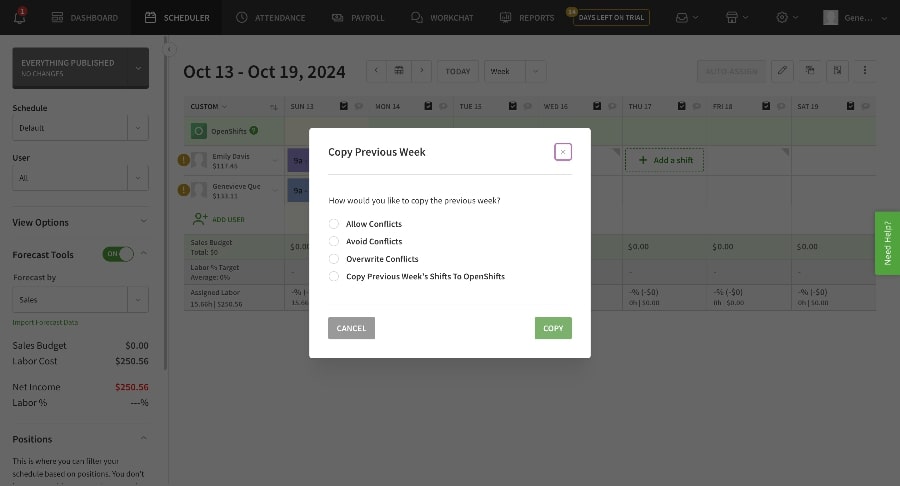
When I Work’s scheduler allows you to copy a previous schedule instead of building a new one, saving you time (Source: When I Work)
Deputy: Best HR Platform with Workforce Management Features

Pros
- Easy to set up
- Flexible weekly plan for seasonal businesses
- 24/7 email support
- Meal & rest break planning
Cons
- Pricing is a bit confusing
- Has a minimum spend of $25 AUD/USD or 15 GBP per month
- Some integrations are a bit buggy
Overview
Who should use it:
I recommend Deputy for businesses that have limited HR staff because it integrates its workforce management software with an HR platform. These features include hiring, applicant management, onboarding, document management, and employee surveys.
Deputy is also the only provider on this list that offers a special plan for seasonal businesses. It has a Flexible Weekly plan that costs less than its regular pricing tiers. What’s good about it is that it only charges per active user.
Additionally, Deputy has a bulk actions feature, allowing bulk importing or updating team member data, approving leaves, updating employee assignments, and importing schedules with just a few clicks. By streamlining these administrative tasks, managers save countless hours to simultaneously update, modify, or process multiple employee records, schedules, or payroll items instead of handling them individually.
Why I like it:
By combining HR and workforce management solutions under one platform, small business owners (who often wear multiple hats) can save time from having everything in one place. It also ensures data consistency and reduces errors since employee information only needs to be entered once and automatically syncs across all functions.
While Homebase has HR features, these are limited to the higher-tiered plans; meanwhile, Deputy’s HR platform is an add-on, but it can be added to all its plans, even the Flexi Weekly plan. Additionally, it has compliance tools that help businesses adhere to the Fair Workweek guidelines.
Deputy would have scored higher with all its features but it took a hit in the pricing and support criteria. For its pricing, it has no free plan and requires a minimum spend of $25 AUD/USD every month, which might not be ideal for businesses with less than 20 people. It also lacks phone and live chat support.
Pricing
- Scheduling ($4.50/user/month): Unlimited shifts, PTO & leave management, demand planning, availability management
- Time & Attendance ($4.50/user/month): Unlimited timesheets, performance & journaling, Timeclock with geolocation capture
- Premium ($6/user/month): Everything in Scheduling and Time & Attendance
- Flexi Weekly ($2.50/active user/week): All the features in Premium
Add-on:
Key Features
- AI-Optimized Scheduling: Compared to all the other software on this list, only Deputy analyzes the foot traffic and weather so you can modify your schedule based on these data. Another standout feature is its option to choose pre-loaded sample data from six different industries (restaurant, bar, etc.), or use your own. This is helpful to a new business building its first schedule.
- Compliance Alerts: When you set a schedule on Deputy and you are not aware it has some compliance issues, it will immediately notify you so you can check it before you even implement it. This saves businesses from any trouble caused by non-compliance.
- Communication Tools: Deputy provides robust communication tools for you and employees to stay in touch. It has a news feed option that lets you post information for your whole team, such as when you plan to open late due to bad weather, or need to remind employees to order new uniforms. You can also assign tasks to employees, and send SMS/email notifications. It also has a journal function where you can track your performance management documentation.
- Meal & Break Planning: This allows businesses to schedule multiple breaks and break types in one shift, including paid rest breaks and unpaid meal breaks. And, with an all-in-one HR and scheduling system, you can automatically track meals and break compliance. For example, the system can flag violations on employee records and generate automated compliance reports when breaks are missed or taken late. It can also feed the data into payroll for proper premium pay calculations where required by law.
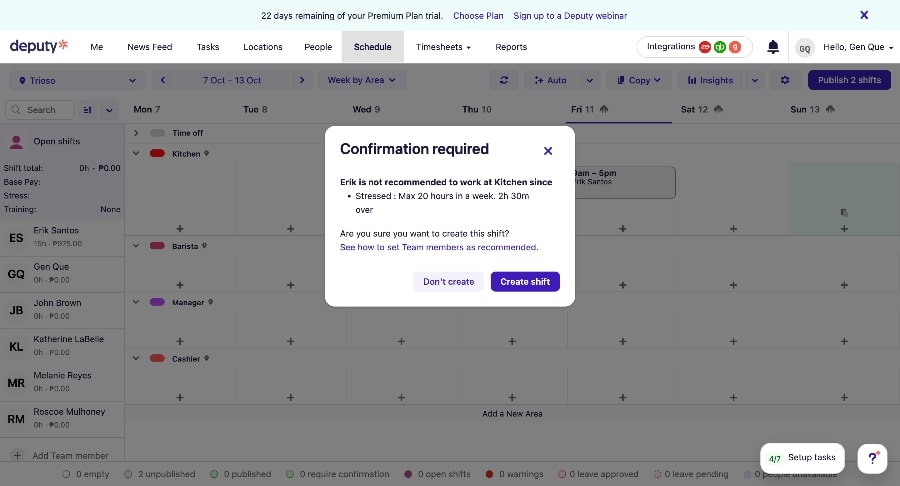
Deputy will notify you whether an employee is fit to work under certain conditions (Source: Deputy)
Connecteam: Best for Mobile Teams
Pros
- Has certification and training tracking
- Has recognition and rewards
- Monitors employee life cycles
Cons
- No auto-scheduling and forecasting
- Limited integrations
- No live support
Overview
Who should use it:
We recommend Connecteam for businesses with field or remote workers because it offers a comprehensive suite of features tailored to the needs of mobile and dispersed workforces. While When I Work also has similar features, Connecteam’s mobile-first capability allows you to access all its features like creating schedules and assigning tasks to your team on your mobile phone.
Additionally, Connecteam has a free plan that gives you access to all its features. The catch, however, is that it is limited to 10 people only. If you are a business with this number of people, Connecteam is an ideal choice.
Why I like it:
I like Connecteam’s push notifications and read receipts because it helps businesses maintain clear communication accountability. It instantly alerts employees about schedule changes, time-sensitive tasks, policy updates, and urgent situations (i.e. workplace accidents or severe weather warnings), while allowing managers to verify who has seen these important messages. It also reduces miscommunication-related issues like overlooked deadlines or missed shifts.
While Connecteam’s communication features are as stellar as Deputy’s, it is not included in its Operations hub (where you can find scheduling and time tracking), but in its Communications hub, which you need to purchase separately ($35/month for the first 30 users). This additional cost can be problematic for businesses on a budget.
Pricing
- Small Business Plan (Free for up to 10 users): Give you access to all hubs and features
Operations Hub
- Basic ($35/month for the first 30 users + $0.6/additional user): Geolocation stamps, clock in/clock out, checklists & forms
- Advanced ($59/month for the first 30 users + $1.8/additional user): Everything in Basic + shift replacement, add shift in bulk, push notification
- Expert ($119/month for the first 30 users + $3.6/additional user): Everything in Advanced + schedule limitations, new device login alert
- Enterprise (Custom pricing)
HR & Skills Hub: Same pricing structure as HR Hub
Communications Hub: Same pricing structure as HR Hub
Key Features
- Knowledge Base: This is where all your company files are kept—from employee contacts to employee handbooks, company policies, and other important documents. These files are stored in the cloud and can be assigned with different access levels and permission controls. That way, you can protect sensitive data and know who has access to what.
- In-app Messaging: While Homebase and When I Work have in-app messaging, Connecteam allows you to email, send a text message, or call colleagues. Thus, you have an alternative to contact them even without an internet connection.
- Timeline: This is another unique Connecteam feature that helps you view each of your employees’ timelines and check any important events, including annual reviews and salary raises, as well as completed and upcoming training. This helps you make better decisions that will benefit both employees and your business.
- Task Management: While the other providers on this list have task management features, only Connecteam has the capability to let you attach documents (i.e checklists, to-do lists, forms) to the scheduled task. This ensures clear work instructions by letting managers include essential references directly within the assignment. It also eliminates confusion and reduces back-and-forth communication.
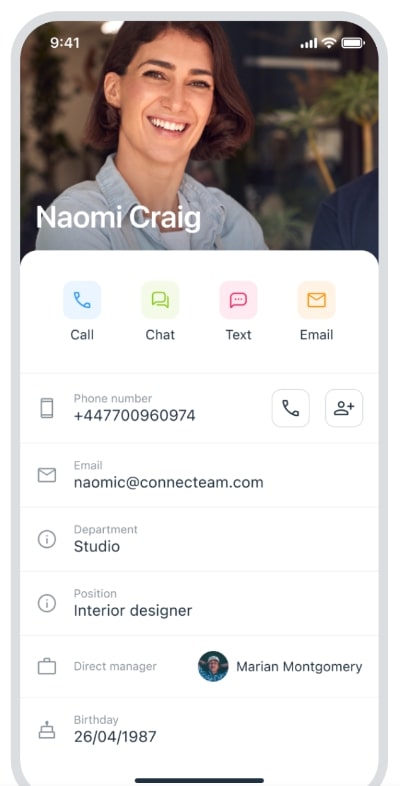
Connecteam’s Directory makes it easy to access your employees any time anywhere (Source: Connecteam)
Zoho People: Best in Affordability

Pros
- Free plan includes employee data and time off management tools
- Affordable monthly rates
- Comprehensive employee onboarding
Cons
- Set up is a bit complicated
- Premium support costs extra
- Hiring and payroll cost extra
Overview
Who should use it
I recommend Zoho People to startups with very small teams wanting to transition to an HR system at no cost. It has a free forever plan that comes with an HR employee database and time off management (for up to five users). If you’re not yet ready to spend money on HR software but want to start organizing your employee data and establishing set processes, this plan can work for you.
Why I like it
I like Zoho People because it already has HR features in its basic plan, which includes time off and file management. It also has an HR bot that helps employees when applying for time off, clocking in/clocking out, and answering any HR-related questions they might have. It’s also the only provider on this list that combines its HR and workforce management features and offers them for free.
However, its HR features in the free plan are limited and not as comprehensive as Deputy’s, which has labor law and fair workweek compliance. If you want to access the advanced HR and workforce management modules—like scheduling, overtime calculation, compensation management, and geolocation—you need to get the more expensive plans.
This is one of the reasons why Zoho People lost significant points under the scheduling criterion. It also took a hit in its platform/interface because setting it up is a bit complicated, especially when uploading employees in bulk. Zoho People offers a separate service (Zoho Jumpstart) where Zoho experts will do the whole setup process for you.
Pricing
- Free Plan (up to 5 users)
- Essential HR ($1.50/user/month):Employee onboarding, file management, employee self-service, module-based reports
- Professional ($2.50/user/month): Everything in Essential + shift scheduling, shift rotation, geolocation, time tracking
- Premium ($3.50/user/month): Everything in Professional + compensation management, employee engagement, 360°feedback
- Enterprise ($5/user/month):
- People Plus ($10/user/month): Everything in Premium + SElf and blended learning, course management
Key Features
- Employee Onboarding: If you have temporary workers and want to manage their information without providing system access, online profiles can be added starting at 23 cents per employee profile monthly (fees vary, depending on the Zoho People plan selected).
- PTO Management: Even the Essential version (the second-lowest) of Zoho People helps track PTO, holidays, and time-off policies. It automates tedious time-off tasks, such as managing leave policies and approvals, calculating time-off accruals, handling multiple-location holidays, and reporting. Tools are available via mobile, so managers can track time off and manage permissions in real time. This helps businesses maintain optimal staffing levels while ensuring fair time-off allocation, preventing schedule conflicts, and streamlining the request approval process.
- Module-based Reports: This feature allows managers to generate customized analytics across different HR functions, like attendance patterns, leave usage, performance metrics, and employee demographics, with each module offering specific reporting templates with relevant data. These reports are crucial for businesses seeking to optimize their workforce management as they provide actionable insights for reducing costs, improving productivity, and maintaining compliance across all HR operations.
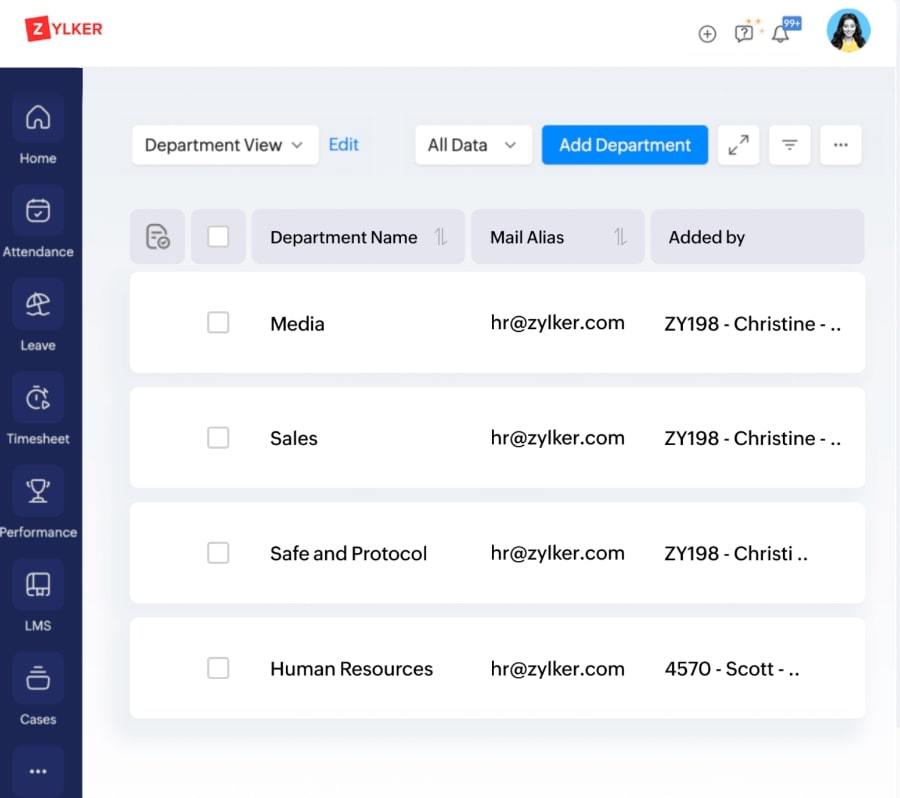
Zoho People allows you to divide your workforce by departments, locations, and job roles. (Source: Zoho People)
Methodology: How We Evaluated
To find the best workforce management software, I compared the 12 most popular workforce management software against features that are most important for managing the workforce. Aside from pricing, ease of use, and popularity, I also looked at each software’s scheduling, time tracking, and reporting capabilities.
5% of Overall Score
I gave higher points to providers with more than 300 reviews and star ratings on popular third-party review websites.
18% of Overall Score
My evaluation considered the monthly costs and any setup fees associated with the providers, with a focus on transparency regarding pricing information available on their websites. I prioritized providers that offer pricing plans below $30 per month for a single employee and do not have setup fees.
10% of Overall Score
I look at the number of support they offer and whether it’s 24/7 or not. Providers that have more than one type of support option get more points. Additionally, they get an extra point if they have round-the-clock support.
13% of Overall Score
For this criterion, I considered how easy it is to navigate the platform even for those with little tech knowledge. I look at how widgets are placed, the fonts and colors used, and customization options it offers.
19% of Overall Score
For time and attendance, I considered how seamless the clocking-in/clocking-out process is. I also checked whether it has multiple avenues for clocking in/out and gave extra points to providers whose timesheets are attached to the POS.
19% of Overall Score
I prioritized providers that do not have time tracking capabilities but also those with breaktime, overtime, and PTO management. I also gave extra points to those with geofencing and push notifications.
16% of Overall Score
Scheduling is one of the key features of a good workforce management tool. Thus, WFM software that allows shift swapping and labor forecasting received a higher score.
Meet the Experts
 | Genevieve has more than 13 years of writing experience, working with different clients in various industries. Genevieve also worked as an HR Head of a local manufacturing company, and has helped small businesses set up their business and HR processes. |
 | Jessica Dennis is the HR lead writer at TechnologyAdvice and also lends her expertise reviewing content for Fit Small Business. She has B.A. in English Literature from the University of Michigan and over six years of experience in onboarding, payroll, benefits, compliance, and workforce management as an HR generalist. Since joining TA, she’s covered additional topics like DEI, engagement, training, communication, hiring, and performance management best practices. Her expertise, in-depth research, and hands-on experience with HR software ensures she provides the best people operations and technology insights to readers. When she’s not writing, you can find her obsessing over her labrador retriever, crocheting, or jumping into the nearest body of water. |

